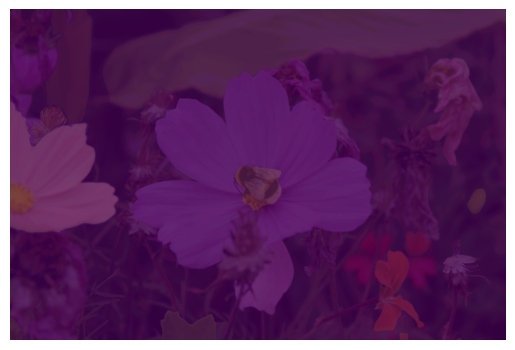Transformers documentation
Mask Generation
Mask Generation
Mask generation is the task of generating semantically meaningful masks for an image. This task is very similar to image segmentation, but many differences exist. Image segmentation models are trained on labeled datasets and are limited to the classes they have seen during training; they return a set of masks and corresponding classes, given an image.
Mask generation models are trained on large amounts of data and operate in two modes.
- Prompting mode: In this mode, the model takes in an image and a prompt, where a prompt can be a 2D point location (XY coordinates) in the image within an object or a bounding box surrounding an object. In prompting mode, the model only returns the mask over the object that the prompt is pointing out.
- Segment Everything mode: In segment everything, given an image, the model generates every mask in the image. To do so, a grid of points is generated and overlaid on the image for inference.
Mask generation task is supported by Segment Anything Model (SAM). It’s a powerful model that consists of a Vision Transformer-based image encoder, a prompt encoder, and a two-way transformer mask decoder. Images and prompts are encoded, and the decoder takes these embeddings and generates valid masks.

SAM serves as a powerful foundation model for segmentation as it has large data coverage. It is trained on SA-1B, a dataset with 1 million images and 1.1 billion masks.
In this guide, you will learn how to:
- Infer in segment everything mode with batching,
- Infer in point prompting mode,
- Infer in box prompting mode.
First, let’s install transformers:
pip install -q transformers
Mask Generation Pipeline
The easiest way to infer mask generation models is to use the mask-generation pipeline.
>>> from transformers import pipeline
>>> checkpoint = "facebook/sam-vit-base"
>>> mask_generator = pipeline(model=checkpoint, task="mask-generation")Let’s see the image.
from PIL import Image
import requests
img_url = "https://huggingface.co/datasets/huggingface/documentation-images/resolve/main/bee.jpg"
image = Image.open(requests.get(img_url, stream=True).raw).convert("RGB")
Let’s segment everything. points-per-batch enables parallel inference of points in segment everything mode. This enables faster inference, but consumes more memory. Moreover, SAM only enables batching over points and not the images. pred_iou_thresh is the IoU confidence threshold where only the masks above that certain threshold are returned.
masks = mask_generator(image, points_per_batch=128, pred_iou_thresh=0.88)The masks looks like the following:
{'masks': [array([[False, False, False, ..., True, True, True],
[False, False, False, ..., True, True, True],
[False, False, False, ..., True, True, True],
...,
[False, False, False, ..., False, False, False],
[False, False, False, ..., False, False, False],
[False, False, False, ..., False, False, False]]),
array([[False, False, False, ..., False, False, False],
[False, False, False, ..., False, False, False],
[False, False, False, ..., False, False, False],
...,
'scores': tensor([0.9972, 0.9917,
...,
}We can visualize them like this:
import matplotlib.pyplot as plt
plt.imshow(image, cmap='gray')
for i, mask in enumerate(masks["masks"]):
plt.imshow(mask, cmap='viridis', alpha=0.1, vmin=0, vmax=1)
plt.axis('off')
plt.show()Below is the original image in grayscale with colorful maps overlaid. Very impressive.

Model Inference
Point Prompting
You can also use the model without the pipeline. To do so, initialize the model and the processor.
from transformers import SamModel, SamProcessor, infer_device
import torch
device = infer_device()
model = SamModel.from_pretrained("facebook/sam-vit-base").to(device)
processor = SamProcessor.from_pretrained("facebook/sam-vit-base")To do point prompting, pass the input point to the processor, then take the processor output
and pass it to the model for inference. To post-process the model output, pass the outputs and
original_sizes and reshaped_input_sizes we take from the processor’s initial output. We need to pass these
since the processor resizes the image, and the output needs to be extrapolated.
input_points = [[[2592, 1728]]] # point location of the bee
inputs = processor(image, input_points=input_points, return_tensors="pt").to(device)
with torch.no_grad():
outputs = model(**inputs)
masks = processor.image_processor.post_process_masks(outputs.pred_masks.cpu(), inputs["original_sizes"].cpu(), inputs["reshaped_input_sizes"].cpu())We can visualize the three masks in the masks output.
import matplotlib.pyplot as plt
import numpy as np
fig, axes = plt.subplots(1, 4, figsize=(15, 5))
axes[0].imshow(image)
axes[0].set_title('Original Image')
mask_list = [masks[0][0][0].numpy(), masks[0][0][1].numpy(), masks[0][0][2].numpy()]
for i, mask in enumerate(mask_list, start=1):
overlayed_image = np.array(image).copy()
overlayed_image[:,:,0] = np.where(mask == 1, 255, overlayed_image[:,:,0])
overlayed_image[:,:,1] = np.where(mask == 1, 0, overlayed_image[:,:,1])
overlayed_image[:,:,2] = np.where(mask == 1, 0, overlayed_image[:,:,2])
axes[i].imshow(overlayed_image)
axes[i].set_title(f'Mask {i}')
for ax in axes:
ax.axis('off')
plt.show()
Box Prompting
You can also do box prompting in a similar fashion to point prompting. You can simply pass the input box in the format of a list
[x_min, y_min, x_max, y_max] format along with the image to the processor. Take the processor output and directly pass it
to the model, then post-process the output again.
# bounding box around the bee
box = [2350, 1600, 2850, 2100]
inputs = processor(
image,
input_boxes=[[[box]]],
return_tensors="pt"
).to(model.device)
with torch.no_grad():
outputs = model(**inputs)
mask = processor.image_processor.post_process_masks(
outputs.pred_masks.cpu(),
inputs["original_sizes"].cpu(),
inputs["reshaped_input_sizes"].cpu()
)[0][0][0].numpy()You can visualize the bounding box around the bee as shown below.
import matplotlib.patches as patches
fig, ax = plt.subplots()
ax.imshow(image)
rectangle = patches.Rectangle((2350, 1600), 500, 500, linewidth=2, edgecolor='r', facecolor='none')
ax.add_patch(rectangle)
ax.axis("off")
plt.show()
You can see the inference output below.
fig, ax = plt.subplots()
ax.imshow(image)
ax.imshow(mask, cmap='viridis', alpha=0.4)
ax.axis("off")
plt.show()